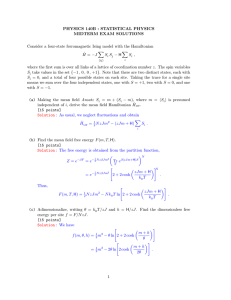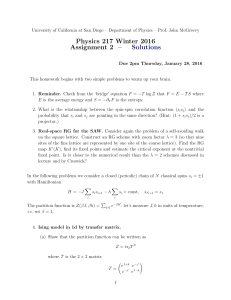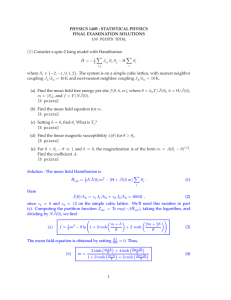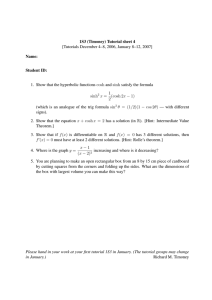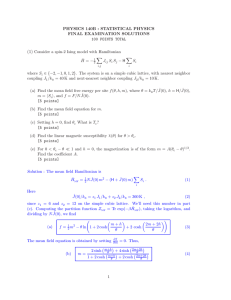(1)
advertisement
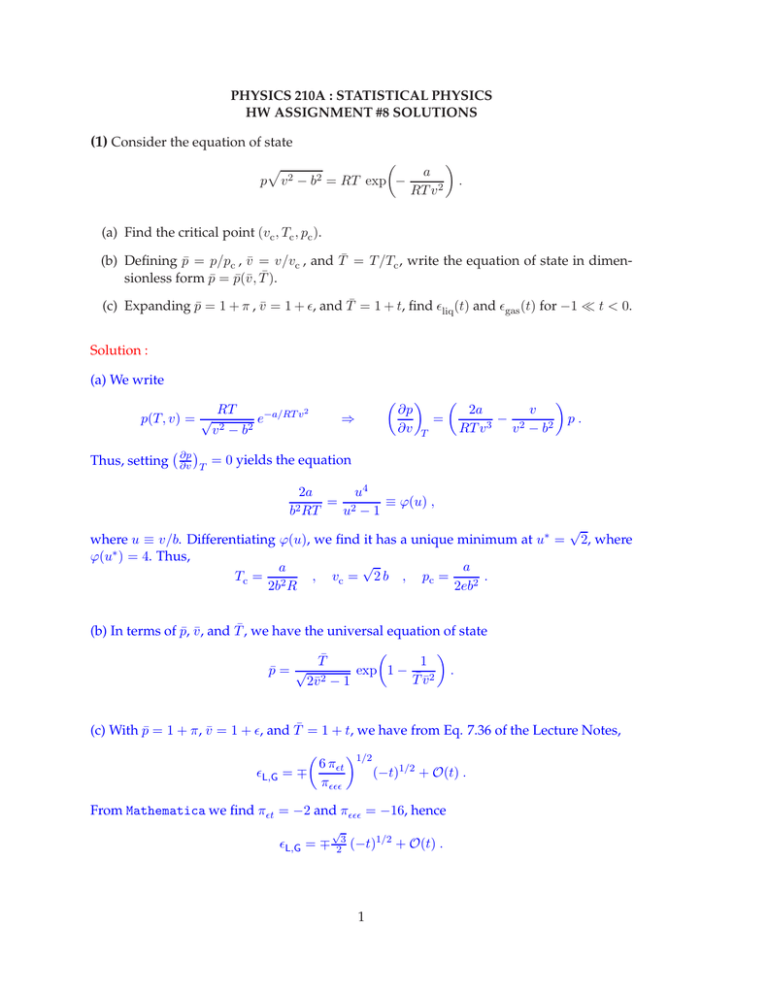
PHYSICS 210A : STATISTICAL PHYSICS
HW ASSIGNMENT #8 SOLUTIONS
(1) Consider the equation of state
p
p
v 2 − b2 = RT exp −
a
RT v 2
.
(a) Find the critical point (vc , Tc , pc ).
(b) Defining p̄ = p/pc , v̄ = v/vc , and T̄ = T /Tc , write the equation of state in dimensionless form p̄ = p̄(v̄, T̄ ).
(c) Expanding p̄ = 1 + π , v̄ = 1 + ǫ, and T̄ = 1 + t, find ǫliq (t) and ǫgas (t) for −1 ≪ t < 0.
Solution :
(a) We write
RT
2
p(T, v) = √
e−a/RT v
⇒
2
2
v −b
∂p = 0 yields the equation
Thus, setting ∂v
T
∂p
∂v
=
T
v
2a
− 2
3
RT v
v − b2
u4
2a
=
≡ ϕ(u) ,
b2 RT
u2 − 1
where u ≡ v/b. Differentiating ϕ(u), we find it has a unique minimum at u∗ =
ϕ(u∗ ) = 4. Thus,
√
a
a
, vc = 2 b , pc =
.
Tc = 2
2b R
2eb2
p.
√
2, where
(b) In terms of p̄, v̄, and T̄ , we have the universal equation of state
1
T̄
exp 1 −
p̄ = √
.
T̄ v̄ 2
2v̄ 2 − 1
(c) With p̄ = 1 + π, v̄ = 1 + ǫ, and T̄ = 1 + t, we have from Eq. 7.36 of the Lecture Notes,
ǫL,G = ∓
6 πǫt
πǫǫǫ
1/2
(−t)1/2 + O(t) .
From Mathematica we find πǫt = −2 and πǫǫǫ = −16, hence
ǫL,G = ∓
√
3
2
(−t)1/2 + O(t) .
1
(2) Consider a set of magnetic moments on a cubic lattice (z = 6). Due to the cubic
anisotropy, the system is modeled by the Hamiltonian
X
X
Ĥ = −J
n̂i · n̂j − H ·
n̂i ,
i
hiji
where at each site n̂i can take one of six possible values: n̂i ∈ {±x̂ , ±ŷ , ±ẑ}.
(a) Find the mean field free energy f (θ, m, h), where θ = kB T /6J and h = H/6J.
(b) Find the self-consistent mean field equation for m, and determine the critical temperature θc (h = 0). How does m behave just below θc ? Hint: you will have to go
beyond O(m2 ) to answer this.
(c) Find the phase diagram as a function of θ and h when h = h x̂.
Solution :
(a) The effective mean field is Heff = zJm + H, where m = hn̂i i. The mean field Hamiltonian is
X
ĤMF = 21 N zJm2 − Heff ·
n̂i .
i
With h = H/zJ and θ = kB T /zJ, we then have
f (θ , h , m) = −
=
1
2
kB T
ln Tr e−Ĥeff /kB T
N zJ
"
#
m
+
h
m
+
h
m
+
h
y
y
x
x
z
z
m2x + m2y + m2z − θ ln 2 cosh
.
+ 2 cosh
+ 2 cosh
θ
θ
θ
∂f
(b) The mean field equation is obtained by setting ∂m
= 0 for each Cartesian component
α
α ∈ {x, y, z} of the order parameter m. Thus,
sinh mx θ+hx
,
mx =
m +h
cosh mx θ+hx + cosh y θ y + cosh mz θ+hz
with corresponding equations for my and mz . We now set h = 0 and expand in powers of
1 4
m, using cosh u = 1 + 12 u2 + 24
u + O(u6 ) and ln(1 + u) = u − 21 u2 + O(u3 ). We have
!
2 + m2 + m2
4 + m4 + m4
m
m
z
y
x
z
y
x
+
+ O(m6 )
f (θ , h = 0 , m) = 21 m2x + m2y + mz − θ ln 6 +
θ2
12 θ 4
m2x m2y + m2y m2z + m2z m2x
1
+ O(m6 ) .
= −θ ln 6 + 12 1 − 3θ
m2x + m2y + m2z +
36 θ 3
2
2
We see that the quadratic term is negative for θ < θc = 13 . Furthermore, the quadratic term
depends only on the magnitude of m and not its direction. How do we decide upon the
direction, then? We must turn to the quartic term. Note that the quartic term is minimized
when m lies along one of the three cubic axes, in which case the term vanishes. So we know
that in the ordered phase m prefers to lie along ±x̂, ±ŷ, or ±ẑ. How can we determine its
magnitude? We must turn to the sextic term in the expansion:
f (θ , h = 0 , m) = −θ ln 6 +
1
2
1−
1
3θ
m2 +
m6
+ O(m8 ) ,
3240 θ 5
which is valid provided m = mn̂ lies along a cubic axis. Extremizing, we obtain
h
i1/4
m(θ) = ± 540 θ 4 (θc − θ)
≃
20 1/4
(θc
3
− θ)1/4 ,
where θc = 31 . So due to an accidental cancellation of the quartic term, we obtain a nonstandard mean field order parameter exponent of β = 14 .
(c) When h = h x̂, the magnetization will choose to lie along the x̂ axis in order to minimize
the free energy. One then has
"
#
m+h
1 2
1
2
f (θ, h, m) = −θ ln 6 + 2 m − θ ln 3 + 3 cosh
θ
= −θ ln 6 + 32 (θ − θc ) m2 +
3
40
m6 − hm + . . . ,
where in the second line we have assumed θ ≈ θc , and we have expanded for small m
and h. The phase diagram resembles that of other Ising systems. The h field breaks the
m → −m symmetry, and there is a first order line extending along the θ axis (i.e. for h = 0)
from θ = 0 and terminating in a critical point at θ = θc . As we have seen, the order
parameter exponent is nonstandard, with β = 41 . What of the other critical exponents?
Minimizing f with respect to m, we have
3(θ − θc ) m +
9
20
m5 − h = 0 .
For θ > θc and m small, we can neglect the O(m5 ) term and we find m(θ, h) =
corresponding to the familiar susceptibility exponent γ = 1.
h
3(θ−θc ) ,
Consider next the heat capacity. For θ > θc the free energy
q is f = −θ ln 6 , arising from the
entropy term alone, whereas for θ < θc we have m2 =
f (θ < θc , h = 0) = −θ ln 6 −
2
q
20
3
20
3
(θc − θ)1/2 , which yields
(θc − θ)3/2 .
∂ f
−1/2 , corresponding
Thus, the heat capacity, which is c = −θ ∂θ
2 , behaves as c(θ) ∝ (θc − θ)
1
to α = 2 , rather than the familiar α = 0 .
Finally, we examine the behavior of m(θc , h). Setting θ = θc , we have
f (θc , h , m) = −hm +
3
9
40
m6 + O(m8 ) .
Setting
∂f
∂m
= 0, we find m ∝ h1/δ with δ = 5, which is also nonstandard.
(3) A magnet consists of a collection of local moments which can each take the values
Si = −1 or Si = +3. The Hamiltonian is
X
X
Ĥ = − 12
Jij Si Sj − H
Si .
i,j
i
ˆ
(a) Define m = hSi i, h = H/J(0),
θ = kB T /Jˆ(0). Find the dimensionless mean field free
energy per site, f = F/N Jˆ(0) as a function of θ, h, and m.
(b) Write down the self-consistent mean field equation for m.
(c) At θ = 0, there is a first order transition as a function of field between the m = +3
state and the m = −1 state. Find the critical field hc (θ = 0).
(d) Find the critical point (θc , hc ) and plot the phase diagram for this system.
Solution :
(a) We invoke the usual mean field treatment of dropping terms quadratic in fluctuations,
ˆ m + H and a mean field Hamiltonian
resulting in an effective field Heff = J(0)
ĤMF =
2
1
ˆ
2 N J (0) m
− Heff
N
X
Si .
i=1
The free energy is then found to be
f (θ, h, m) = 12 m2 − θ ln e3(m+h)/θ + e−(m+h)/θ
2(m + h)
1 2
= 2 m − m − h − θ ln cosh
− θ ln 2 .
θ
(b) We extremize f with respect to the order parameter m and obtain
2(m + h)
m = 1 + 2 tanh
.
θ
(c) When T = 0 there are no fluctuations, and since the interactions are ferromagnetic we
may examine the two uniform states. In the state where Si = +3 for each i, the energy is
ˆ − 3N H. In the state where S = −1 ∀ i, the energy is E = 1 N J(0)
ˆ + N H.
E1 = 29 N J(0)
2
i
2
ˆ , i.e. h = −1.
Equating these energies gives H = −J(0)
(d) The first order transition at h = −1 and θ = 0 continues in a curve emanating from this
point into the finite θ region of the phase diagram. This phase boundary is determined by
4
Figure 1: Phase diagram for problem 3.
the requirement that f (θ, h, m) have a degenerate double minimum as a function of m for
fixed θ and h. This provides us with two conditions on the three quantities (θ, h, m) , which
in principle allows the determination of the curve h = hc (θ). The first order line terminates
in a critical point where these two local minima annihilate with a local maximum, which
∂ 3f
∂ 2f
∂f
= ∂m
requires that ∂m
2 = ∂m3 = 0 , which provides the three conditions necessary to
determine (θc , hc , mc ). Now from our expression for f (θ, h, m), we have
2(m + h)
∂f
= m − 1 − 2 tanh
∂m
θ
∂ 2f
4
2 2(m + h)
= 1 − sech
∂m2
θ
θ
2(m + h)
∂ 3f
16
2 2(m + h)
= 2 tanh
sech
.
∂m3
θ
θ
θ
Now set all three of these quantities to zero. From the third of these, we get m + h = 0,
which upon insertion into the second gives θ = 4. From the first we then get m = 1, hence
h = −1.
For a slicker derivation, note that the free energy may be written
2(m + h)
2
1
f (θ, h, m) = 2 (m + h) − θ ln cosh
− (1 + h)(m + h) + 12 h2 − θ ln 2 .
θ
Thus, when h = −1, we have that f is an even function of m−1. Expanding then in powers
of m + h , we have
f (θ, h = −1, m) = f0 + 12 1 − 4θ (m − 1)2 + 3θ43 (m − 1)4 + . . . ,
whence we conclude θc = 4 and hc = −1.
5
